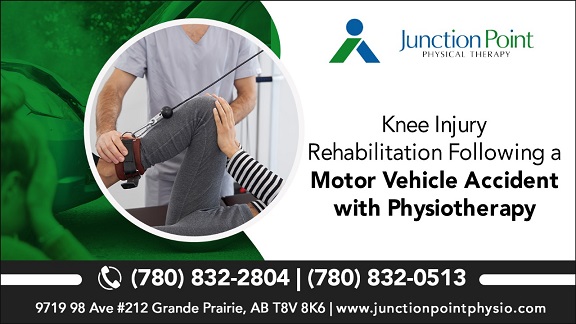
Knee injuries are common in motor vehicle accidents (MVAs), often resulting from the sudden impact and the forces involved during a crash. The knee is a vulnerable joint due to its complex structure and its role in supporting the body’s weight and movement. In a car accident, the knees can experience direct trauma, twisting forces, or the force of the collision, all of which can lead to a range of injuries. motor vehicle accident Physiotherapy Grande Prairie At Junction Point Physical Therapy , we help individuals recover from knee injuries sustained in MVAs with a comprehensive approach that includes assessment, treatment, and rehabilitation.
Common Types of Knee Injuries in Car Accidents
Ligament Injuries (ACL, PCL, MCL, LCL)
The ligaments in the knee help stabilize and support the joint. In a car accident, the knee can be subjected to twisting motions, hyperextension, or direct impact, leading to ligament tears or sprains.
Anterior Cruciate Ligament (ACL) – One of the most commonly injured ligaments in MVAs, the ACL is responsible for preventing the tibia (shinbone) from sliding too far forward. Tearing the ACL often results in instability, pain, and difficulty bearing weight.
Posterior Cruciate Ligament (PCL) – Less common but still significant, the PCL can be injured when the knee is struck directly, typically in a dashboard collision where the knee hits the dashboard forcefully.
Medial Collateral Ligament (MCL) and Lateral Collateral Ligament (LCL) – The MCL and LCL help stabilize the knee against side-to-side movements. In MVAs, the knee can twist or bend sideways, causing tears or sprains in these ligaments.
Meniscus Tears
The meniscus is a cartilage structure that acts as a cushion between the femur (thighbone) and tibia (shinbone). During a collision or impact, the knee may twist or rotate suddenly, causing tears in the meniscus. Symptoms include pain, swelling, limited motion, and a feeling of the knee locking or giving way.
Fractures
Knee fractures can occur when the knee is directly impacted, such as in a front-end collision where the knees strike the dashboard or steering wheel. These fractures can affect the patella (kneecap), femur, or tibia. Depending on the severity, fractures can lead to intense pain, swelling, and difficulty moving the knee.
Patellar Dislocation
Patellar dislocation occurs when the kneecap (patella) moves out of its normal position, typically due to a sudden twist or direct impact to the knee during an accident. This injury can cause the knee to become locked in place, with pain and swelling around the kneecap.
Contusions and Soft Tissue Injuries
In addition to fractures and ligament tears, contusions (bruises) and other soft tissue injuries are common in MVAs. The knee can absorb force from the impact, causing muscle strains, bruising, and damage to surrounding tissues such as ligaments, tendons, and cartilage. While these injuries may not require surgery, they can lead to pain, stiffness, and decreased function in the knee joint.
Knee Sprains and Strains
A sprain refers to the stretching or tearing of a ligament, while a strain involves muscle or tendon injury. Both injuries can occur in an accident due to sudden movements or impact, leading to swelling, tenderness, and difficulty using the knee properly.
Treatment for Knee Injuries in Car Accidents
Physiotherapy
Physiotherapy is a cornerstone of treatment for knee injuries. At Junction Point Physical Therapy, we use a combination of manual therapy, strengthening exercises, and range-of-motion techniques to help restore function and reduce pain.
Strengthening exercises target muscles that support the knee, like the quadriceps, hamstrings, and calf muscles, helping improve stability and prevent future injuries.
Joint mobilizations help reduce stiffness and improve mobility in the knee joint.
Ice, Rest, and Elevation
For acute injuries, resting the knee, applying ice, and keeping the leg elevated are key in reducing swelling and inflammation in the initial phase of recovery.
Bracing and Taping
Knee braces and taping techniques can provide support during recovery and prevent further damage to the injured area while promoting healing.
Surgery
In cases of severe ligament tears, fractures, or dislocations, surgical intervention may be necessary to repair or reconstruct damaged tissues and restore knee function. Post-surgery physiotherapy is critical for regaining strength and mobility.
Conclusion
Knee injuries are common and potentially debilitating after a motor vehicle accident, but with the right treatment approach, individuals can recover and return to normal activities. At Junction Point Physical Therapy in Grande Prairie, we offer personalized rehabilitation plans that incorporate physiotherapy, pain management, and functional exercises to address the full spectrum of knee injuries. If you’ve suffered a knee injury from an accident, contact us today to start your recovery and regain your mobility and strength.
#motorvehicleaccidentphysiotherapygrandeprairie #junctionpointphysicaltherapy #motorvehicleaccidentphysiotherapy #motorvehicleaccidentgrandeprairie #physiotherapynearme #physiotherapygrandeprairie #physicaltherapygrandeprairie #physicaltherapynearme #physicaltherapy #caraccidentphysiotherapygrandeprairie